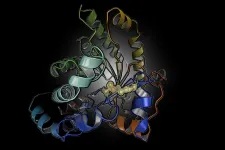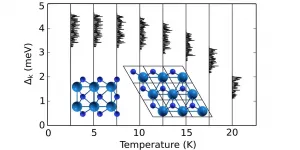Long-acting injectable medicine as potential route to COVID-19 therapy
2021-05-05
(Press-News.org) Researchers from the University of Liverpool have shown the potential of repurposing an existing and cheap drug into a long-acting injectable therapy that could be used to treat Covid-19.
In a paper published in the journal Nanoscale, researchers from the University's Centre of Excellence for Long-acting Therapeutics (CELT) demonstrate the nanoparticle formulation of niclosamide, a highly insoluble drug compound, as a scalable long-acting injectable antiviral candidate.
The team started repurposing and reformulating identified drug compounds with the potential for COVID-19 therapy candidates within weeks of the first lockdown. Niclosamide is just one of the drug compounds identified and has been shown to be highly effective against SARS-CoV-2 in a number of laboratory studies.
Using their expertise in the fields of materials chemistry, long-acting drug delivery and pharmacology, CELT scientists used nanoprecipitation to form redispersible solid drug nanoparticle formulations of niclosamide that can be stored as solids, reconstituted with water and utilised as long acting injectables. Their research has demonstrated sustained circulating drug concentrations may be maintained for the duration of early infection after a single injection.
CELT is co-directed by pharmacologist Professor Andrew Owen and materials chemist Professor Steve Rannard at the University of Liverpool.
Professor Steve Rannard said: "Repurposing drug compounds is much more than using existing medicines for a new disease. The existing active drug compound needs to be shown to be active at a significant level, then reformulated to address new challenges. The conventional route of administration may also not be relevant and modifying the way the patient receives the drug compound is highly critical to efficacy. Niclosamide is an ideal candidate to be taken forward as a potential long acting injectable therapeutic to treat Covid-19.
"This is still in early-stage development but the CELT team are currently working with a contract manufacturing organisation to take this forward towards scale up and clinical manufacture. This work is progressing well and if successful, human trials would be next. We envisage a future `Test-and-Treat' scenario where infected people are treated at the point of diagnosis with the full course of therapy in one injection."
Professor Andrew Owen said: "Repurposing of medicines for SARS-CoV-2 has yielded mixed results, with some clear successes for immunomodulatory drugs such as dexamethasone, and work underway to repurpose drugs like favipiravir and molnupiravir that were designed for other viruses.
"The ultimate utility of our long-acting injectable can only be determined in adequately powered and well controlled randomised clinical trials but unlike other drugs that have been explored for repurposing niclosamide target concentrations may be achievable in humans. The formulation has shown great promise in preclinical studies at a time when it is increasingly evident that drugs are urgently required to compliment the vaccines.
"A global pandemic requires a global solution, and it is critical that interventions are available to everyone and not to the privileged few. Accordingly, we are currently working to remove obstacles to availability in low- and middle-income countries to ensure equitable access if clinical success is ultimately demonstrated."
This research paper builds on previous reports released from the team in April 2020 and published in Clinical Pharmacology and Therapeutics. The CELT team have strongly advocated in further publications in the British Journal of Clinical Pharmacology, that repurposing of drugs requires new strategies that encompass reformulation and specific dose optimisation that addresses the needs of SARS-CoV-2 treatment.
INFORMATION:
CELT is focused on repurposing existing medicines into slow-release formulations where drug effectiveness can be sustained over several months. This `long-acting' technology has already been successfully implemented in the fields of contraception and schizophrenia. It also has the potential to bolster global efforts to tackle - and even eliminate - major diseases affecting low- and middle-income countries, including HIV/AIDS.
The long-acting therapy development from the team was initiated and supported by funds from the EPSRC and the progression to scale-up and manufacture has received support from Unitaid. The team are actively seeking partners for the next steps of product development and translation.
Established as part of a £30.5 million ($40m) international research consortium, primarily funded by Unitaid, CELT is the first of its kind in the world. For further information, please visit the CELT website. You can also follow the centre on Twitter.
The paper `Scalable nanoprecipitation of niclosamide and in vivo demonstration of long-acting delivery after intramuscular injection' (doi:10.1039/D1NR00309G) is published in Nanoscale.
ELSE PRESS RELEASES FROM THIS DATE:
2021-05-05
New Johns Hopkins University simulations offer an intriguing look into Saturn's interior, suggesting that a thick layer of helium rain influences the planet's magnetic field.
The models, published this week in AGU Advances, also indicate that Saturn's interior may feature higher temperatures at the equatorial region, with lower temperatures at the high latitudes at the top of the helium rain layer.
It is notoriously difficult to study the interior structures of large gaseous planets, and the findings advance the effort to map Saturn's hidden regions.
"By ...
2021-05-05
The incorporation of boron into polycyclic aromatic hydrocarbon systems leads to interesting chromophoric and fluorescing materials for optoelectronics, including organic light-emitting diodes (OLEDS) and field-effect transistors, as well as polymer-based sensors. In the journal Angewandte Chemie, a research team has now introduced a new anionic organoborane compound. Synthesis of the borafluorene succeeded through the use of carbenes.
Borafluorene is a particularly interesting boron-containing building block. It is a system of three carbon rings joined at the edges: two six-membered and one central five-membered ring, whose free tip is the boron atom. While neutral, radical, and cationic (positively ...
2021-05-05
Proteins perform a vast array of functions in the cell of every living organism with critical roles in almost every biological process. Not only do they run our metabolism, manage cellular signaling and are in charge of energy production, as antibodies they are also the frontline workers of our immune system fighting human pathogens like the coronavirus. In view of these important duties, it is not surprising that the activity of proteins is tightly controlled. There are numerous chemical switches that control the structure and, therefore, the function of proteins in response to changing environmental conditions and stress. ...
2021-05-05
Philadelphia, May 5, 2021--When Luke Terrio was about seven months old, his mother began to realize something was off. He had constant ear infections, developed red spots on his face, and was tired all the time. His development stagnated, and the antibiotics given to treat his frequent infections stopped working. His primary care doctor at Children's Hospital of Philadelphia (CHOP) ordered a series of blood tests and quickly realized something was wrong: Luke had no antibodies.
At first, the CHOP specialists treating Luke thought he might have X-linked agammaglobulinemia (XLA), a rare immunodeficiency syndrome seen in children. However, as the CHOP research team continued investigating Luke's case, they realized Luke's condition was unlike any disease described ...
2021-05-05
Pesticides have been used in European agriculture for more than 70 years, so monitoring their presence, levels and their effects in European soils quality and services is needed to establish protocols for the use and the approval of new plant protection products.
In an attempt to deal with this issue, a team led by the prof. Dr. Violette Geissen from Wageningen University (Netherlands) have analysed 340 soil samples originating from three European countries to compare the contentdistribution of pesticide cocktails in soils under organic farming practices and soils under conventional practices. This study was a combined effort of 3 EC funded projects addressing soil
quality: RECARE (http://www.recare-project.eu/), iSQAPER (http://www.isqaper-project.eu) ...
2021-05-05
T-cells play a central role in our immune system: by means of their so-called T-cell receptors (TCR) they make out dangerous invaders or cancer cells in the body and then trigger an immune reaction. On a molecular level, this recognition process is still not sufficiently understood.
Intriguing observations have now been made by an interdisciplinary Viennese team of immunologists, biochemists and biophysicists. In a joint project funded by the Vienna Science and Technology Fund and the FWF, they investigated which mechanical processes take place when an antigen is recognized: ...
2021-05-05
Larger bumblebees are more likely to go out foraging in the low light of dawn, new research shows.
University of Exeter scientists used RFID - similar technology to contactless card payments - to monitor when bumblebees of different sizes left and returned to their nest.
The biggest bees, and some of the most experienced foragers (measured by number of trips out), were the most likely to leave in low light.
Bumblebee vision is poor in low light, so flying at dawn or dusk raises the risk of getting lost or being eaten by a predator.
However, the bees benefit from extra foraging time and fewer competitors for pollen in the early morning.
"Larger bumblebees have bigger eyes than their smaller-sized nest mates and many other bees, and can therefore see better in dim light," said lead author ...
2021-05-05
Superconductivity in two-dimensional (2D) systems has attracted much attention in recent years, both because of its relevance to our understanding of fundamental physics and because of potential technological applications in nanoscale devices such as quantum interferometers, superconducting transistors and superconducting qubits.
The critical temperature (Tc), or the temperature under which a material acts as a superconductor, is an essential concern. For most materials, it is between absolute zero and 10 Kelvin, that is, between -273 Celsius and -263 Celsius, too cold to be of any practical use. Focus has then been on finding materials with a higher Tc.
While researchers have discovered materials ...
2021-05-05
A curiously yellow pre-supernova star has caused astrophysicists to re-evaluate what's possible at the deaths of our Universe's most massive stars. The team describe the peculiar star and its resulting supernova in a new study published today in Monthly Notices of the Royal Astronomical Society.
At the end of their lives, cool, yellow stars are typically shrouded in hydrogen, which conceals the star's hot, blue interior. But this yellow star, located 35 million light years from Earth in the Virgo galaxy cluster, was mysteriously lacking this crucial hydrogen layer at the time of its explosion.
"We haven't seen this scenario before," said Charles Kilpatrick, postdoctoral fellow at Northwestern ...
2021-05-05
How can a highly effective drug be transported to the precise location in the body where it is needed? In the journal Angewandte Chemie, chemists at Heinrich Heine University Düsseldorf (HHU) together with colleagues in Aachen present a solution using a molecular cage that opens through ultrasonification.
Supramolecular chemistry involves the organization of molecules into larger, higher-order structures. When suitable building blocks are chosen, these systems 'self-assemble' from their individual components.
Certain supramolecular compounds are well suited for 'host-guest chemistry'. In such cases, a host structure encloses a guest molecule and can shield, protect and transport it away from its environment. This is a specialist field of Dr. Bernd M. Schmidt and ...
LAST 30 PRESS RELEASES:
[Press-News.org] Long-acting injectable medicine as potential route to COVID-19 therapy





